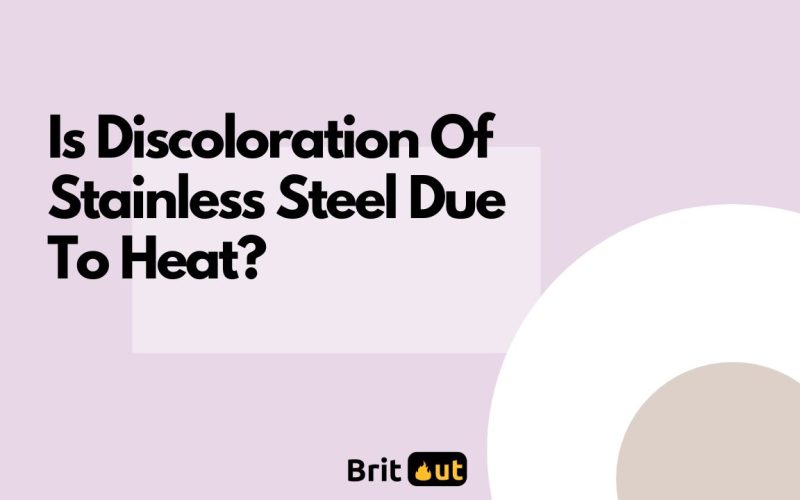If you’ve ever used stainless steel cookware or appliances, you may have noticed that they can develop discoloration over time.
This discoloration can be caused by a variety of factors, including exposure to heat. But is heat the culprit?
In this post, I will share with you other factors that can contribute to stainless steel discoloration.
Let’s get to it.
Is Discoloration Of Stainless Steel Due To Heat?
One of the most common causes of discoloration in stainless steel is exposure to heat.
When stainless steel is heated to high temperatures, it can undergo a process called “temper coloring,” which causes the surface to change colors.
This process happens because of the formation of a thin oxide layer on the surface of the steel, which reflects light differently depending on its thickness and the angle of incidence.
The colors that appear during temper coloring can range from gold and brown to blue and purple, and they can be quite beautiful.
However, they can also be an indication of damage to the stainless steel and can compromise its strength and durability if left unchecked.
In addition to temper coloring, exposure to heat can also cause other types of discoloration in stainless steel.
For example, if the stainless steel is exposed to high temperatures for prolonged periods, it can become yellowed or develop dark spots.
This type of discoloration is often referred to as “heat tinting” or “heat staining” and is caused by the formation of a thick oxide layer on the surface of the steel.
While some types of discoloration can be purely cosmetic, others can be a sign of more serious problems.
For example, discoloration in stainless steel cookware can indicate that the metal is leaching into your food, which can be a health risk. Additionally, discoloration in stainless steel equipment used in harsh environments, such as chemical processing plants, can be a sign of corrosion and can compromise the safety and effectiveness of the equipment.
So, while heat can certainly be a cause of discoloration in stainless steel, it’s important to understand why this happens and what steps you can take to prevent or mitigate it.
Some best practices for preventing heat-related discoloration in stainless steel include:
- Avoiding exposure to high temperatures for prolonged periods
- Using a lower heat setting when cooking with stainless steel cookware
- Using a heat diffuser when cooking with stainless steel cookware on a gas stove
Regularly cleaning and maintaining stainless steel items to prevent the buildup of contaminants and acids that can contribute to discoloration and corrosion.
Other Factors That May Contribute To Stainless Steel Discoloration
While exposure to heat is a common cause of discoloration in stainless steel, other factors can also contribute to this problem.
In this section, I will explore some of the other factors that you should be aware of.
One factor that can cause discoloration in stainless steel is exposure to acidic substances. Stainless steel is highly resistant to corrosion, but it is not completely immune to it.
When stainless steel comes into contact with acids, such as lemon juice or vinegar, it can react with the acid and cause discoloration or even corrosion.
This is why it’s important to avoid using acidic cleaners on stainless steel surfaces and to rinse off any acidic substances as soon as possible.
Another factor that can contribute to discoloration in stainless steel is exposure to salt.
Salt can be highly corrosive to metals, including stainless steel.
This is especially true in environments with high humidity or in coastal areas where salt water is present.
If you have stainless steel items in these types of environments, it’s important to regularly clean and maintain them to prevent salt buildup and corrosion.
Additionally, exposure to harsh chemicals can also cause discoloration in stainless steel.
Chemicals such as bleach, ammonia, and chlorine can all damage the protective oxide layer on stainless steel and cause it to discolor or corrode. If you need to clean stainless steel with a chemical cleaner, be sure to use one that is specifically formulated for stainless steel and follow the manufacturer’s instructions carefully.
Finally, physical damage can also cause discoloration in stainless steel.
Scratches or other types of damage to the surface of the steel can create areas where corrosion can occur.
Over time, this corrosion can cause discoloration or even pitting on the surface of the steel.
How To Prevent Discoloration On Stainless Steel?
Now that you know the common causes of discoloration on stainless steel, let’s talk about some tips and tricks to prevent it from happening in the first place.
One of the most important things you can do to prevent discoloration on stainless steel is to avoid exposing it to high heat for extended periods.
If you’re cooking on a stainless steel surface, try to keep the heat at a moderate level and avoid leaving the pan or pot on the burner for too long. Additionally, if you’re using a stainless steel oven or grill, be sure to follow the manufacturer’s instructions for proper use and care.
Another way to prevent discoloration on stainless steel is to clean it regularly.
This not only helps to remove any buildup or residue that may be present, but it also helps to prevent the buildup of oils and other substances that can contribute to discoloration.
When cleaning stainless steel, be sure to use a non-abrasive cleaner and a soft cloth or sponge to avoid scratching the surface.
You can also apply a protective coating to your stainless steel items to help prevent discoloration. There are many different types of coatings available, such as clear sealants or wax-based products, that can help to protect the surface of the steel from exposure to heat and other damaging substances.
Just be sure to choose a product that is specifically formulated for use on stainless steel and follow the instructions carefully.
Finally, it’s important to avoid exposing stainless steel to acidic substances or harsh chemicals.
As I mentioned earlier, exposure to acids and chemicals can cause discoloration and even corrosion on stainless steel.
To prevent this from happening, be sure to clean up any spills or splatters as soon as possible and avoid using harsh chemicals or acidic cleaners on your stainless steel items.
Without a doubt, preventing discoloration on stainless steel is largely a matter of proper use and maintenance.
Conclusion
Discoloration on stainless steel can be caused by a variety of factors, with heat being one of the most common culprits.
However, other factors such as exposure to acids and chemicals, as well as improper use and maintenance, can also contribute to discoloration. The good news is that there are steps you can take to prevent discoloration on your stainless steel items, such as avoiding high heat, cleaning regularly, applying protective coatings, and avoiding exposure to harsh substances.






